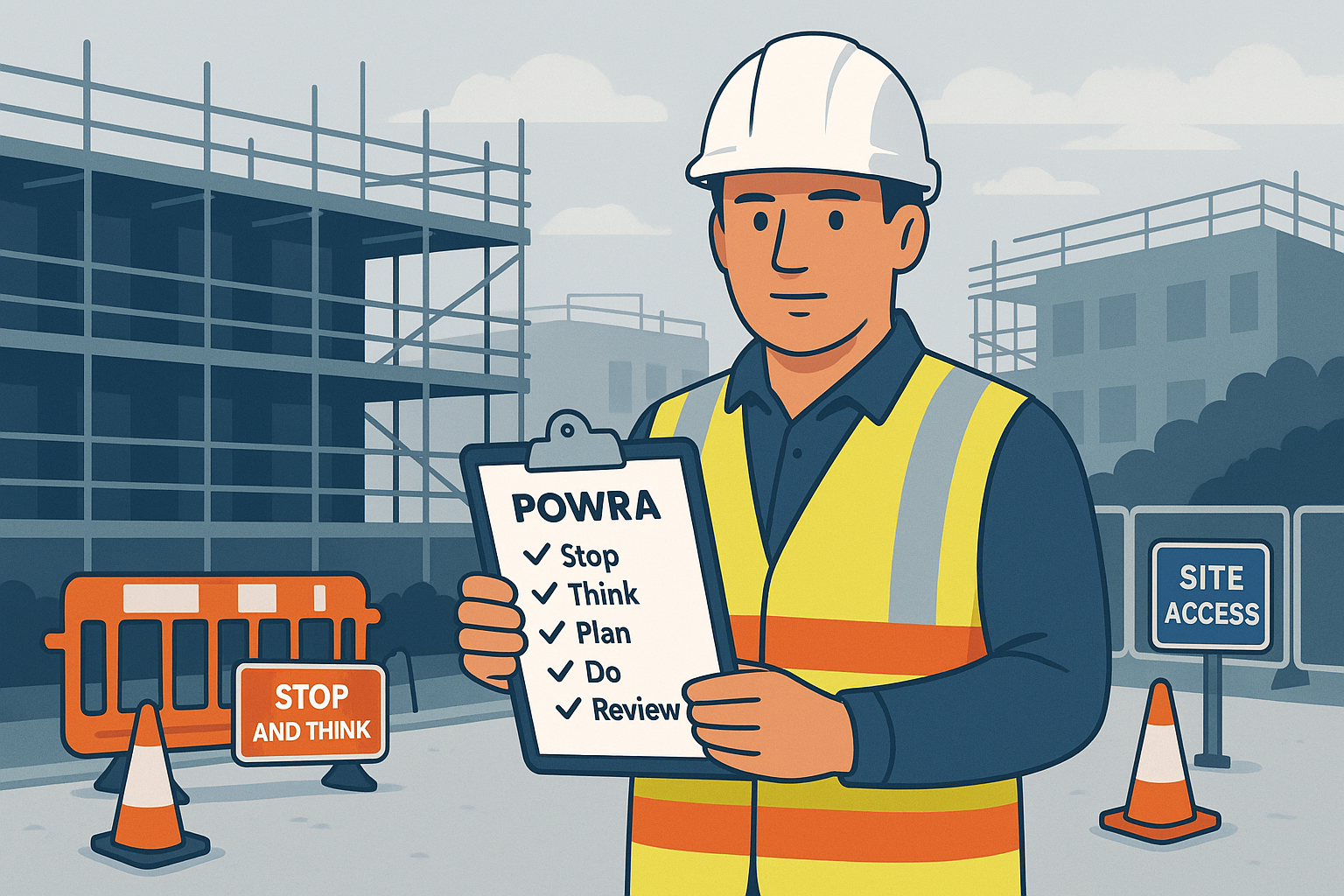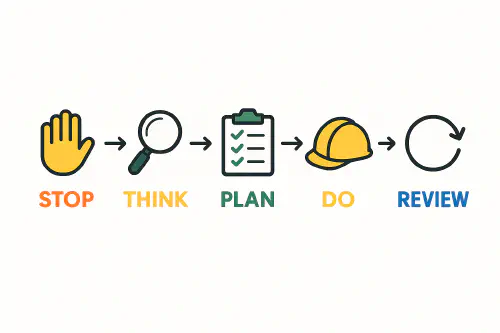
Dynamic risk assessment on site: a simple POWRA that crews actually use
Dynamic risk assessment on site: a simple POWRA that crews actually use
Category: Hiring, Training & HR • Niche: Toolbox talks, dynamic risk assessment, POWRA, site inductions
Contents
- Quick answer
- What HSE expects and where POWRA fits
- The 5‑step POWRA used by UK site teams
- Set it up in under 60 minutes
- Run it daily: scripts and prompts
- Record keeping that stands up in audits
- What to link and learn next
- FAQ

Foreman holding a POWRA checklist on a UK construction site
Quick answer
Dynamic risk assessment is the quick sense‑check you do at the point of work when conditions change. In construction we call this a POWRA (point of work risk assessment). It does not replace your written risk assessment and RAMS. It’s a 30–90 second stop and think: spot the hazards, confirm the right controls are in place, brief the crew, and only then crack on. If anything changes, you stop and repeat.
What HSE expects and where POWRA fits
- HSE requires that risks are assessed and controlled, following a suitable and sufficient process. Start with a documented risk assessment and method statement for the job. See HSE’s 5‑step model and examples: Risk assessment.
- Under CDM, duty holders must plan, manage and monitor so work is safe. Use method statements and pre‑task briefings to communicate controls, e.g. for work at height: Planning for construction work and Assessing all work at height.
- Toolbox talks are encouraged to keep messages short and focused: HSE toolbox talks.
- So where does POWRA sit? It’s the on‑the‑day check that your RAMS still match reality. If the plan and the actual conditions differ, you stop, adjust the controls and, if needed, amend RAMS/permits before work.
The 5‑step POWRA used by UK site teams

POWRA flow: Stop, Think, Plan, Do, Review
- Stop
- Pause at the point of work. If anything looks different to the RAMS, do not start.
- Typical change triggers: new trades in your zone, weather shift, missing edge protection, plant movement, blocked access, new hot works nearby.
- Think
- What could hurt someone here and now? Use this 10‑point scan:
- People and plant interface, traffic routes, banksman in place
- Work at height edges, openings, fragile surfaces
- Temporary works, excavations, lifting operations
- Services identified and isolated, permits signed
- Housekeeping, slips and trip routes
- Fire routes, hot works, cylinders
- Dust, silica, COSHH, RPE and LEV
- Noise and vibration
- Weather, lighting, visibility
- Welfare and emergency arrangements
- Plan
- Match hazards to controls. Confirm they are in place and effective:
- Exclusion zones, barriers, signage
- Edge protection, MEWP/scaffold checks, harness use
- Permits to work, lock out tag out
- Lifting plan and roles agreed
- RPE fit and LEV on, water suppression for cutting
- Fire watch, extinguishers, no‑spark tools where needed
- Clear access/egress; tidy as you go
- Do
- Brief the team in plain language. Who is doing what, and what stop‑work triggers to watch for.
- Get a quick sign‑on if your firm requires it.
- Review
- If anything changes, stop and re‑assess. Escalate if a control cannot be put in place. No job is worth a shortcut.
Set it up in under 60 minutes
The goal is zero faff so supervisors and subbies actually use it.
- Create a one‑page POWRA form (paper or Google Form/Jotform) with the 5 steps and the 10‑point scan above. Keep it to one screen.
- Make a site QR that opens the form. Print and place at access points, in vans and near high‑risk zones.
- Add stop‑work authority into the form: If a control is missing, work stops and a supervisor is alerted.
- Add a simple sign‑on for the brief: names or initials are enough for most audits.
- Train your leads with a 10‑minute demo during induction.
Recommended external references to anchor your setup:
- HSE construction overview: Construction health and safety
- Work at height method statement guidance: Assessing all work at height
- Traffic management controls: Vehicles and traffic management
- Build UK induction guidance for consistent site rules: Build UK Site Induction Guidance
- CECA Stop. Make a Change campaign for “stop and think” culture: Stop. Make a Change
Run it daily: scripts and prompts
Use these one‑minute scripts at the start of each task. Read it exactly if you like.
Work at height quick brief
- Hazard: unprotected edge, dropped objects.
- Controls: full edge protection, tool lanyards, exclusion zone, MEWP pre‑use check, rescue plan known.
- Stop if: guardrail removed, wind picks up, different kit arrives.
Cutting and dust quick brief
- Hazard: silica dust, eye injury.
- Controls: water suppression or LEV, RPE to standard, goggles, cutting zone taped, spark risk checked.
- Stop if: LEV fails, water runs out, wrong disc.
People and plant quick brief
- Hazard: struck‑by, reversing plant.
- Controls: segregation, banksman agreed, radios checked, speed and routes confirmed.
- Stop if: banksman leaves, route blocked, public enters zone.
Want more scripts? See our toolbox talk pieces: Toolbox talk attendance QR code and Toolbox talks UK: what HSE expects.
Record keeping that stands up in audits
- Keep it short, but keep it. A single page or a simple digital form is fine.
- Capture:
- Date, site, task, RAMS ID
- The 10‑point scan ticked yes/no
- Controls confirmed or actions taken
- Briefing sign‑on
- Store with your job pack. Weekly export to PDF is enough for most clients.
- If you use digital forms, auto‑email any “no” answers to the site manager so issues are fixed the same day.
What to link and learn next
- HSE toolbox talk library for ready‑made briefings: HSE toolbox talks
- Build UK information hub for policies you can reference in site rules: Build UK resources
- Considerate Constructors Best Practice Hub: practical examples and materials to support your site standards: CCS Best Practice Hub
FAQ
Is POWRA a legal requirement?
- The law requires a suitable and sufficient risk assessment and safe systems of work. POWRA is a practical way to check, at the point of work, that your RAMS still fit. It complements your paperwork.
Do I have to record every POWRA?
- Record significant findings and any changes to controls. Many firms keep a quick daily record plus sign‑on. Keep it light or it won’t get used.
Can POWRA replace RAMS?
- No. Use it to pick up real‑time changes and reinforce stop‑work authority.
What does HSE say about dynamic risk assessment?
- HSE doesn’t mandate that term. Stick to the 5‑step risk assessment model and show that you plan, brief and monitor. Links above.
What if a subcontractor refuses to stop work?
- Your site rules should give supervisors the authority to stop unsafe work. Back it up at induction and in your contracts.
—
Want to slash training times and increase revenue per Engineer? Join our Waitlist: https://trainar.ai/waitlist